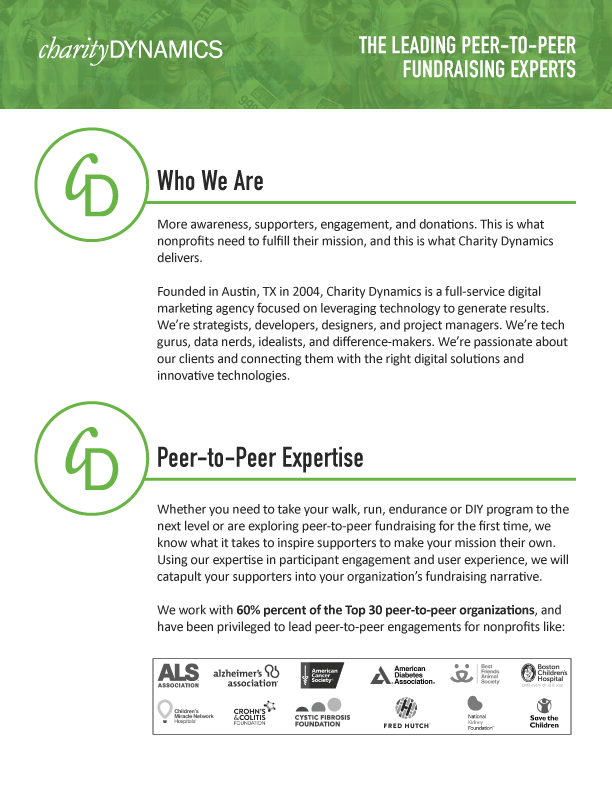Peer-To-Peer Perspectives
Program Makeover: Reframe P2P Strategy through Mission Engagement
Watch Other P2P Videos in Our Series:
- 3 Tips to Help Optimize Your EOY Content & Messaging
- Key Takeaways from the 2020 P2P Professional Forum
- 3 Easy Tips for Kicking off 2020 EOY with a Bang
- Dealing with Disruption in the Industry
- Giving Tuesday Tips: Preparing for Success on Facebook
- Improving User Action Pathways & Donation Forms
- Where do you focus your efforts — on fundraisers or non-performers?
- Favorite User Experience Tools for Nonprofits
- Top Digital Acquisition Strategies for 2019
- Where are you seeing growth in Peer-to-Peer this year?
- Program Makeover: Reframe P2P Strategy through Mission Engagement
- Children Miracle Network Hospitals' Journey to Livestream Fundraising
- 5 Tips to Grow P2P Fundraising
- P2P Trends (Part II): Creativity, Efficiency, Volunteerism
- P2P Trends (Part I): Digital, Customization, Fundraising “Push” Days
- DIY (Part II): The Changing Landscape of P2P Fundraising
- DIY (Part I): DIY Fundraising Is All the Rage
- State of the Industry: P2P Fundraising in 2018
We talked with experts from March of Dimes and Susan G. Komen — two organizations that know a thing or two about reinventing major established P2P programs — about how they’ve handled this challenge.
In our latest installment of our P2P Perspectives video series, we share a number of insights from these two organizations, including:
- How they have evaluated events that weren’t performing
- How to decide when to invest in change (and what that will look like)
- Why you need to examine how you’re framing your P2P fundraising as a whole
Video Transcript
Interview 1: DJ Hampton, SVP and Chief Development Officer, March of Dimes
“P2P is one of the single best engagement opportunities for people and when people shift their perspective from purely about the revenue to understand that it’s an engagement opportunity to tie people to something they already care about, and may or may not know it, it becomes magical. It becomes a way to get people to do things that are bigger than what they can do by simply showing up at the march.
“My biggest recommendation would be to change the framing of what you view peer-to-peer as and to actually look at most of your fundraising and individuals at the local level as peer-to-peer. It’s the single greatest invention—someone asking someone else to join them in giving a gift is something that’s incredible. Why wouldn’t we rebuild that instead of looking at it as over here and actually making it the center of a complete strategy.”
Interview 2: Courtney Bugler, National Director, Race for the Cure, Susan G. Komen
“If you’re selling your event as the reason why people are coming, as we’ve learned a little bit from Komen, you’re not going to get your brand ambassadors, you’re not going to build their affinity, you’re going to get people, when you take away your shiny object, your event, who will feel like there’s not a lot of reason to come. So nobody comes to your event because your water stop is the most entertaining water stop they’ve ever seen. And they’re certainly not fundraising because of that. So for us it really involves moving from selling your event to selling your mission. You make your event experience the culmination of the story you’ve been telling the entire season of your event. Your event is where your story and your brand come to life.”
Interview 1: DJ Hampton, SVP and Chief Development Officer, March of Dimes
“One of the big jobs we had for the campaign was to look at the business model and say where is the best use of resources. How do we get out of spending more than we’re raising and get to a point where revenue and expenses are in line. But more importantly though really creating a compelling mission for our donors, creating a great experience where donors are thanked, informed and feel valued but also at the same time creating those local opportunities where they get tied in and because hopefully passionate advocates for the work we’re doing.
Interview 2: Courtney Bugler, National Director, Race for the Cure, Susan G. Komen
“One of the first questions I always ask is what does that investment look like? Because there is a lot of ways people can think of it as an investment— the most obvious is money. I mean, sure, we need x amount of money, but to me investment is much bigger than money. Investment is resources and human capital. It’s people. But more importantly I want the investment of trust in the process and I want an investment of support by senior management. All the budget in the world won’t help you if you don’t have all levels of your organization who’ve got your back.”



